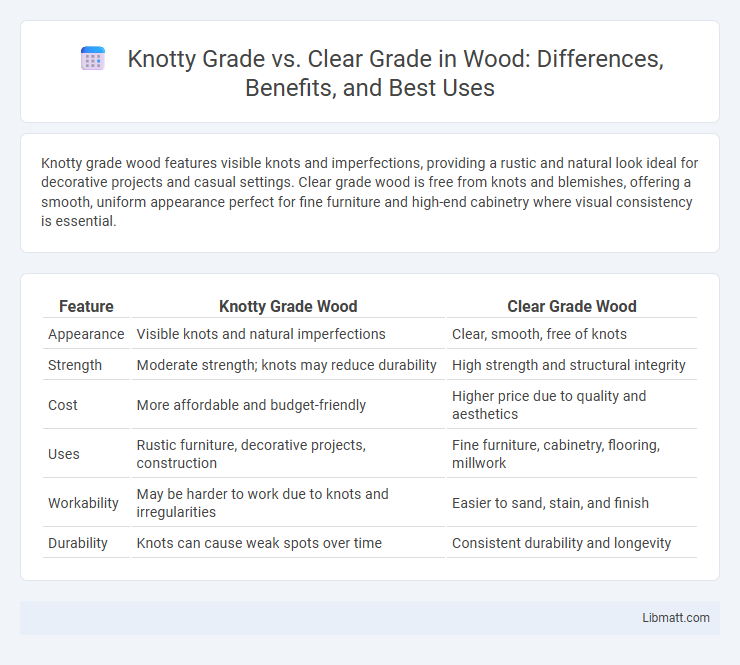Knotty grade wood features visible knots and imperfections, providing a rustic and natural look ideal for decorative projects and casual settings. Clear grade wood is free from knots and blemishes, offering a smooth, uniform appearance perfect for fine furniture and high-end cabinetry where visual consistency is essential.
Table of Comparison
| Feature | Knotty Grade Wood | Clear Grade Wood |
|---|---|---|
| Appearance | Visible knots and natural imperfections | Clear, smooth, free of knots |
| Strength | Moderate strength; knots may reduce durability | High strength and structural integrity |
| Cost | More affordable and budget-friendly | Higher price due to quality and aesthetics |
| Uses | Rustic furniture, decorative projects, construction | Fine furniture, cabinetry, flooring, millwork |
| Workability | May be harder to work due to knots and irregularities | Easier to sand, stain, and finish |
| Durability | Knots can cause weak spots over time | Consistent durability and longevity |
Introduction to Wood Grading
Knotty grade wood contains natural knots and imperfections that add character but may affect structural strength, making it ideal for decorative or rustic applications. Clear grade wood is free from knots and defects, providing a smooth, uniform appearance suitable for fine woodworking and high-quality furniture. Understanding these wood grading differences helps you select the right material for your project based on durability and aesthetics.
Defining Knotty Grade Wood
Knotty grade wood is characterized by visible natural knots, imperfections, and varying grain patterns that add rustic charm and unique character to your woodworking projects. Unlike clear grade wood, which is free of knots and blemishes and offers a smooth, uniform appearance, knotty grade wood provides a textured, organic look that is often preferred for aesthetic appeal in furniture and interior design. Choosing knotty grade wood involves embracing its natural variations, making it ideal for creating warm, inviting spaces.
Characteristics of Clear Grade Wood
Clear grade wood is characterized by its smooth surface, free from knots, pitch pockets, and other natural imperfections, making it ideal for high-quality woodworking projects. It exhibits consistent grain patterns and a uniform color, ensuring a refined and aesthetically pleasing appearance. Your projects benefit from the durability and superior finish Clear grade wood provides, especially in fine furniture and cabinetry.
Visual Differences: Knotty vs Clear
Knotty grade wood features visible knots, natural imperfections, and varied grain patterns, giving it a rustic and textured appearance ideal for casual or country-style designs. Clear grade wood, in contrast, is free from knots, blemishes, and discolorations, resulting in a smooth, uniform surface that suits modern and refined aesthetics. Your choice between knotty and clear grade will impact the overall visual character and style of your woodworking projects.
Applications of Knotty Grade Wood
Knotty grade wood is ideal for rustic furniture, decorative paneling, and construction where natural character and texture add visual interest. Its knots and imperfections provide a unique aesthetic popular in cabins, farmhouse-style interiors, and accent walls. You can enhance spaces requiring a warm, organic feel using knotty grade wood in creative design projects.
Uses of Clear Grade Wood
Clear grade wood is ideal for applications where appearance and smooth finishes are paramount, such as high-end furniture, cabinetry, and interior millwork. Its lack of knots and defects ensures uniform strength and a flawless surface for staining or painting, making it perfect for visible architectural details. When you require a clean, polished look without imperfections, clear grade wood is the preferred choice for premium woodworking projects.
Aesthetic Appeal: Rustic vs Refined
Knotty grade wood showcases a rustic aesthetic with natural knots and imperfections that add character and warmth to your space, making it ideal for cozy, farmhouse-style interiors. Clear grade wood, free of knots and blemishes, offers a refined and smooth appearance that enhances modern and elegant designs. Choosing between these grades depends on whether you prefer a natural, textured look or a sleek, polished finish.
Cost Comparison: Knotty vs Clear
Knotty grade lumber is generally more affordable than clear grade due to visible knots and natural imperfections that reduce manufacturing costs and increase material yield. Clear grade lumber, free of knots and blemishes, commands a higher price because of its premium appearance and suitability for fine woodworking projects. Your choice between knotty and clear grades will impact both budget and aesthetic quality, with knotty offering cost savings and clear providing a sleek, uniform finish.
Durability and Performance Factors
Knotty grade wood features natural knots and imperfections that can slightly reduce its structural integrity compared to clear grade wood, which is free of knots and defects, providing superior durability for load-bearing applications. Clear grade wood offers better performance in terms of strength, stability, and resistance to warping or splitting, making it ideal for projects requiring long-lasting reliability. When selecting wood for your construction or furniture projects, choosing clear grade ensures optimal durability and consistent performance under stress.
Choosing the Right Wood Grade for Your Project
Knotty grade wood features natural knots and imperfections, offering a rustic, authentic appearance ideal for decorative projects or furniture where character is desired. Clear grade wood is free of knots and blemishes, providing a smooth, uniform surface perfect for fine woodworking, cabinetry, and projects requiring a polished finish. Selecting the appropriate wood grade depends on the intended aesthetic, structural needs, and budget constraints of your project.
Knotty grade vs Clear grade Infographic

 libmatt.com
libmatt.com